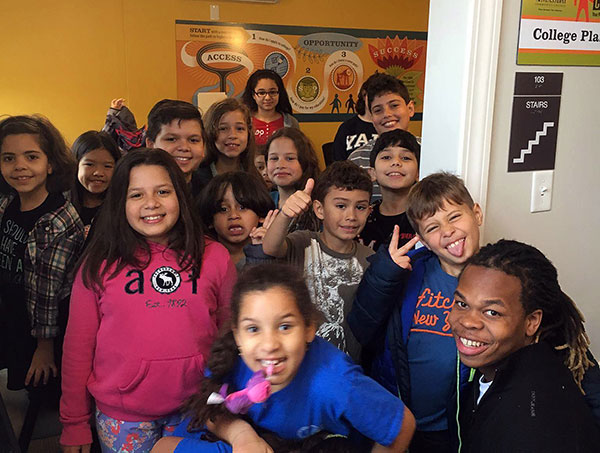
MassBay Community College and Framingham State University used a Vision Project Performance Incentive Fund (VP-PIF) grant to open the Commonwealth’s first regional college planning center with the goal of achieving higher rates of college access and completion among underrepresented groups across MetroWest.
“I always say talent is distributed equally, opportunity is not,” Framingham State President Javier Cevallos said at the opening of the MetroWest College Planning Center (CPC) in September 2015. “I am optimistic about this center in making a big difference in the opportunity for people in this region.”
In its first year, the MetroWest CPC has had the following impacts:
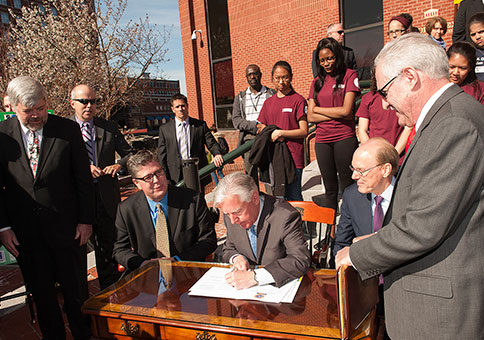
In a systemwide effort to advance the “Big Three” goals, the campuses and DHE have announced the new Commonwealth Commitment to College Access, Affordability and Completion. In less than six months, campus leaders, faculty and staff forged agreement on a groundbreaking plan to freeze college costs, offer end-of-semester tuition and fee rebates and, at the four-year institutions, waive tuition. Students must begin their studies at a community college and then transfer to a state university or UMass campus. They must attend full-time, maintain a cumulative GPA of 3.0 and complete their bachelor’s degree in less than four and a half years.
“This program was designed to decrease the cost of a college degree and accelerate on-time completion for students across the Commonwealth, creating more opportunities and helping more people get into the workforce with the skills they need,” said Governor Charlie Baker. “The Commonwealth Commitment will make it even easier for students to go to school full-time and begin their careers with less debt, and we are pleased that our higher education officials have worked collaboratively to make this program a reality.”
The two-year pilot program will launch in fall 2016 with students able to choose from 14 MassTransfer Pathways degree programs; ten more programs will be added in fall 2017.
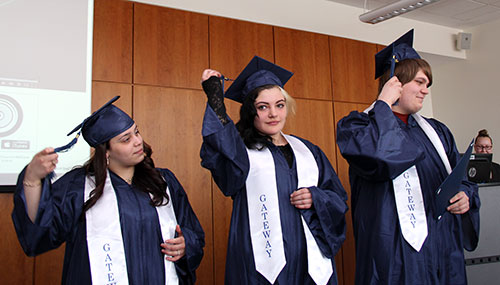
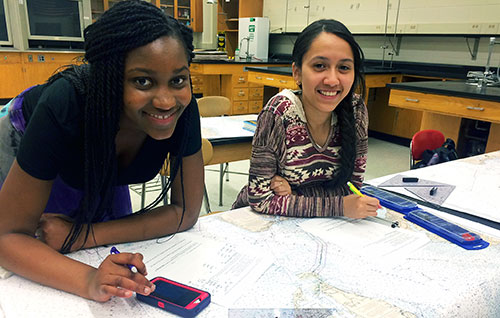
It’s a winning strategy that reduces college costs while also lowering remediation rates: dual enrollment programs that allow students to take college classes while still in high school.
The Commonwealth Dual Enrollment Partnership (CDEP) provides funds to campuses that help reduce the cost of college coursework. In addition to providing a meaningful and challenging early college experience, research suggests dual enrollment opportunities are associated with higher college enrollment and graduation rates.
Massachusetts has set a goal of increasing dual enrollment from 2,000 to 3,400 students, with a renewed focus on recruiting underrepresented students. CDEP funding increased from $750,000 in FY15 to $1 million in FY16. Meanwhile, campuses are ramping up their own dual enrollment and early college programs, some using private funds to supplement public resources.
North Shore Community College has launched CommUniverCity at Lynn, an “urban education-workforce development collaboration” that takes a birth-to-career approach to developing educational pathways into higher education and employment. Working with the Lynn Public Schools and community partners, and with funding from the Federal Reserve Bank of Boston, NSCC rolled out an Early College IT Academic Pathway to allow low-income, first-generation college students to progress from high school to NSCC and then on to Salem State to earn a bachelor’s degree in information technology. Guided academic pathways in business and early childhood education are planned for next year. The initiative builds on North Shore’s existing dual enrollment program at Lynn High, where fully 100 percent of students who enrolled in a college course in 2015 completed and passed it. Ninety-five percent of those students are currently enrolled in their first year of college.
Holyoke Community College has nearly doubled the number of dual enrollment students it serves in the past two years, based on new relationships it has formed with Chicopee Comprehensive High School and Paulo Freire Social Justice Charter School. The College also boasts the nation’s #1 Gateway to College program for high school dropouts, with the highest graduation rates of any Gateway program in the U.S. Since fall 2010, 171 students have earned their high school diplomas by taking college classes at HCC.
Massasoit Community College faculty are teaching dual enrollment courses at seven area high schools, up from three schools in 2011. The number of students taking classes has expanded from 81 to 275. Peter Johnston, Massasoit’s early college partnerships director, recalls a staff person at one local high school telling him that many electives had been eliminated due to budget cuts.
“The administrator was distraught over the potential negative impact to students,” Johnston says. “He asked, ‘Can Massasoit help fill that gap?’ So we’re now offering statistics, psychology and sociology for his students.” Massasoit’s broader goal, according to Johnston, is to help area high school students gain developmental skills for college success out of the way in 9th or 10th grade so they are ready to begin credit-bearing college courses in the 11th grade. At that point students may take dual enrollment classes, so that they can begin their higher education experience earlier.
Massachusetts Maritime Academy has creatively exported its dual enrollment program from its Bourne campus to the John D. O’Bryant School of Math & Science in Roxbury. Once each week an Academy faculty member travels to O’Bryant to teach a dual enrollment class in coastal navigation, which also includes two field trips to the Academy. In just its second semester, enrollment has doubled and 98 percent of participating students have received college credit. The Academy and the high school have expanded their partnership to include scholarships to the Academy’s summer academic camps.
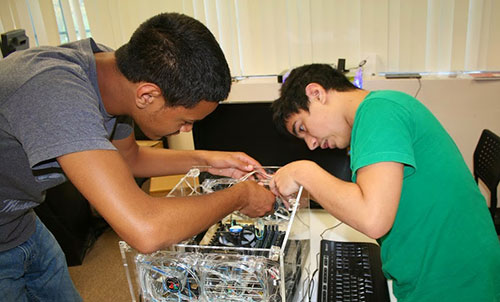
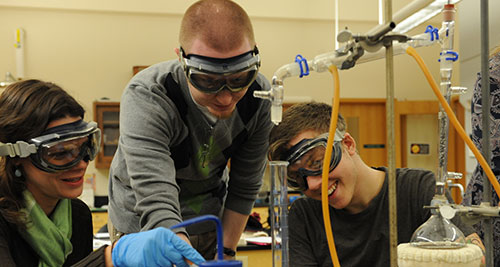
The results are in, and the two-year-old STEM Starter Academy (SSA) program at all 15 Massachusetts community colleges has shown success in its efforts to recruit, retain and graduate more students with science, technology, engineering and math degrees.
The grant-funded SSA program championed by House Speaker Robert DeLeo gives high school students exposure to college-level STEM courses and career tracks. During free summer sessions, students can conquer remedial math coursework, take part in science and engineering challenges such as building digital cameras or genetics labs, and visit industry partners to learn about different STEM careers.
“We created our own oil spills, and then had to be engineers and try to find a way to solve them,” said Erin Holdgate, who attended Massasoit Community College’s STEM Starter Academy before entering the college in 2014. Graduating this spring, Holgate plans to transfer to a four-year university and pursue a career in medicine.
At Quinsigamond Community College, coordinator Darcy Carlson reports that 23 of the 29 students who took part in the summer program then enrolled QCC and are on track to complete their first year in college. More than half the group have chosen STEM majors. “Some of them are asking me, ‘Are you doing it again this year? Can I help?’” Carlson says. “My goal is to double the number of program participants in summer 2016, budget permitting.”
Among the findings of a recent UMass Donahue Institute evaluation of the STEM Starter Academy program:
Like most community colleges, Cape Cod Community College had a history of working closely with local employers to align workforce training with hiring needs. But Tammi Jacobson had a different vision when she became director of the College’s workforce education office. She wanted employers to have “skin in the game,” to collaborate with the Four C’s to move students out of training programs, into paid internships and eventually, jobs that would offer tuition assistance programs to help students further their education and training.
Rather than serve as an employment agency, Jacobsen wanted local companies to have, in essence, an ownership stake in the business of educating the local talent pool. “I wanted them to feel part of the education and training process,” Jacobsen says. “I said to myself, ‘We’re going to train the students, and they are going to hire the students.” To put the new model into practice, Jacobsen rebranded the workforce education division into an on-campus organization called the Center for Corporate and Professional Education.
Enter Charles “Chuck” Robinson (left), a semi-retired insurance executive and one-time student at the Four C’s, who was increasingly concerned about finding job candidates for positions at his own agency and at other agencies across the Cape. He worked with Jacobsen to bring ten agencies to the table, forging a partnership that led to the creation of curriculum for entry-level customer service positions. With as many as half of the state’s 80,000 insurance employees retiring in the next decade, Robinson sees the program as an employer’s lifeline. “The stars lined up on this; I’m hoping we can do it every summer,” Robinson says. “I had reached out to several other colleges, but Cape Cod was the most responsive.”
Twenty students signed up for three weeks of classroom instruction, starting in June 2016. Paid internships, complete with individual mentors provided by the companies, will follow. Robinson fully expects that many if not most of the interns will be hired for permanent positions. An added bonus: at least half of the agencies will offer tuition reimbursement to allow the students to continue their students at the Four C’s while working. The only downside of the program is space availability: the college only has enough computer stations and workspace to accommodate 20 students at a time.
GEAR UP (Gaining Early Awareness and Readiness for Undergraduate Programs) is the Department of Higher Education’s largest college access program, providing 7,000 students in seven low-income districts with tutoring services, mentoring, financial aid counseling, educational and college field trips, college readiness workshops and more.
A 2015 study with Worcester Public Schools found that graduating seniors who participated in the federally funded GEAR UP Massachusetts program were nearly four times more likely to enroll in college than students who did not participate in a college access program.
GEAR UP is now expanding its reach statewide through the Massachusetts College Application Celebration (MCAC), the goal of which is to provide every graduating senior the opportunity to apply to college during the school day with help from guidance counselors, college admissions representatives and volunteers. In 2015, GEAR UP expanded MCAC’s reach to 20 high schools across the state—a 79% increase in students served from 2014.
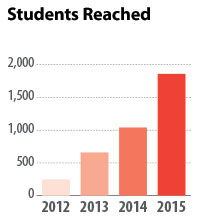

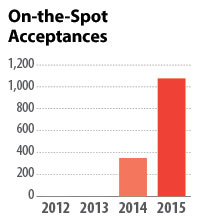

In 2014, Bristol Community College Math Department Chairman Dan Avedikian ditched his textbook in favor of free and easily accessible resources. He saved each student an estimated $250 by creating course content in the form of lecture notes and a series of YouTube videos where he demonstrates how to solve each problem.
He wasn’t alone. Using a grant from the Vision Project Performance Incentive Fund, Bristol launched the Open Educational Resources (OER) initiative to incentivize faculty to replace textbooks and “go for free” materials in the classroom.
“This project has widened access to quality education,” affirms Avedikian. “The high price of textbooks can be a barrier for some qualified students that are already struggling to come up with the money needed for tuition and fees.”
BCC began to see results after just one year. By the close of 2015, courses that utilized OERs generated a total savings of over $33,000 for students and decreased DWFI rates (students receiving D’s, W’s, F’s or Incompletes) by 16 percent.